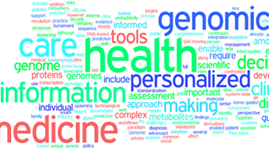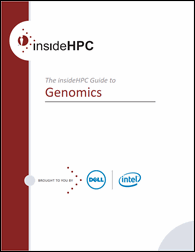This is the forth article in a series from the insideHPC Guide to Genomics that looks at the benefits HPC brings to Genomics as well as many success stories.
Success Stories in Personalized Medicine
Neuroblastoma and Medulloblastoma Translational Research Consortium (NMTRC) is a group of 18 universities and children’s hospitals headquartered at the Helen DeVos Children’s Hospital in Grand Rapids, Michigan. The group offers a nationwide network of childhood cancer clinical trials. These trials are based on the research from a group of collaborative investigators that are linked with laboratory programs and developing novel therapies for high-risk neuroblastoma and medulloblastoma.
“Working with partners like Dell, TGen and NMTRC, we’re seeing an entirely new reality in patient care, starting with clinical trials,” says Giselle Sholler, MD MSC chair, Neuroblastoma and Medulloblastoma Translational Research Consortium and endowed director of the Haworth Innovative Therapeutics Clinic at Helen DeVos Children’s Hospital.
“In this new model, information technology is the bridge that connects all the clinical disciplines for truly personalized patient care. It’s a team-based approach that includes bioinformatics, genomics, oncology and pharma in a way that really delivers on the promise of improved outcomes in the lives of children that participate in our studies.” Giselle Sholler, MD MSC chair, NMTRC
A leading research clinic studies a wide range of areas, including biomedical engineering, cancer biology, cellular and molecular medicine, genomic medicine, immunology, molecular cardiology, molecular genetics, neurosciences, ophthalmic research, pathobiology, stem cell biology and regenerative medicine, and oncology research. This research institute first discovered that storage was needed beyond a common desktop computer, and thus added a petabyte storage system. The next step was to implement a computer system that could respond to the most demanding computational problems. The customer turned to Dell and Intel® to provide a solution that consisted of the latest Intel Xeon processors in Dell PowerEdge™ servers, which provided multiple teraflops of performance with many terabytes of high-performance storage. Software tools included CentOS Linux, Bright Cluster Manager®, OpenMPI library, GNU Compiler Collection (GCC), Simple Linux Utility for Resource Management (SLURM), Intel Solutions for Lustre® software and the Intel Math Kernel Library (Intel MKL). This organization was able to scale their infrastructure and translate the clinical needs to actionable workflows that help patients.
The results of using the Dell cluster were very positive. Initial run time for a methylation status analysis was reduced from 20 hours to four hours. False discovery rate calculation was reduced from one week to 15 hours.
Multiple runs were now made in a week, as compared with months. Other examples exist of reducing run times from weeks or days to hours. Multiple runs are now possible, which generate the data needed for correlation with cancer types.
In addition to genomic analysis, other science domains use the Dell cluster to enhance their own research and patient records. This includes natural language processing and free text patient notes. Physicians’ hand-written notes are now able to be scanned and converted into text and made part of the electronic health record. Techniques typically associated with structural mechanics such as finite element analysis are being used on the Dell cluster to perform volume simulations on bones, and simulate passive flexion of the knee joint. Run times are reduced from 20 hours to one hour and by 75 percent in another case. Thousands of simulations that were not able to be run previously can now be run.
TGen
TGen helps fight cancer and other diseases through the use of genomics. TGen realized that speed and precision are key to a patient’s survival. To achieve this speed, they found they needed high-performance computing (HPC) to quickly run very complex algorithms. Terabytes of genetic and molecular data are available from patient and research databases. Custom treatments are needed based on the patient’s genome and other biological information.
In order to improve the turnaround time for genomic analyses and create a more customized treatment plan, TGen turned to Dell to deploy an HPC cluster, which would accelerate the time to get results. The Dell GDAP solution consists of Dell PowerEdge servers with Intel Xeon processors, storage arrays and management software.
Time is critical when diagnosing and creating a customized treatment plan. With the Dell DGAP, the time needed for genetic sequencing has been reduced considerably, as well as the analytical processes that facilitate custom treatment from seven days to four hours.
“I’m not aware of any other solution on the market that’s like the Dell Genomic Data Analysis Platform. It’s optimized for genomic workflows out of the box, and within a few days, you can install, configure and launch it into production,” says James Lowey, vice president of technology, Translational Genomics Research Institute. “Today, we help save more lives because researchers spend less time waiting for HPC resources. And it’s also easy for us to scale and customize our Dell Genomic Data Analysis Platform to support our unique requirements.”
Center For Rare Childhood Diseases (C4RCD)
The TGen Center for Rare Childhood Disorders (C4RCD) harnesses the latest technologic leaps in genome sequencing to pinpoint the causes of rare childhood disorders that largely remain a mystery to modern medicine.
“By using the Dell GDAP platform, C4RCD is able to process genetic samples quickly,” said James Lowey, TGen Vice President of Technology. “This is important as many of the families of these children have been on a diagnostic odyssey, often going years without a clear answer about what is causing the condition of their child. By taking advantage of a system designed to process NGS data, researchers can focus on exploration and discovery, instead of IT infrastructure.”
Next week we will look at a few integrated genomic processing infrastructure systems. If you prefer you can download the complete insideHPC Guide to Genomics in PDF form by clicking here, courtesy of Dell and Intel.





